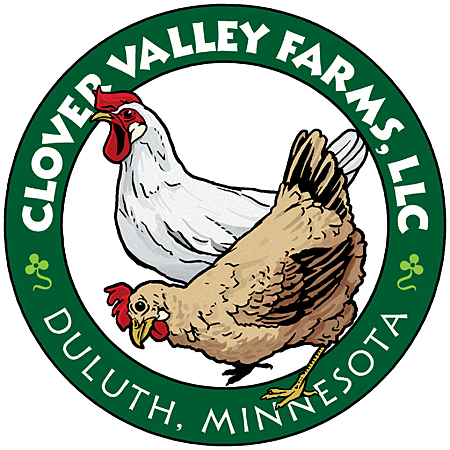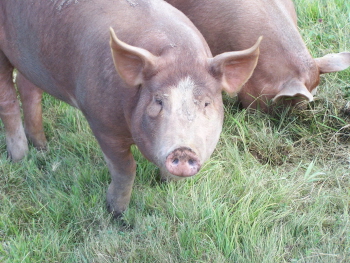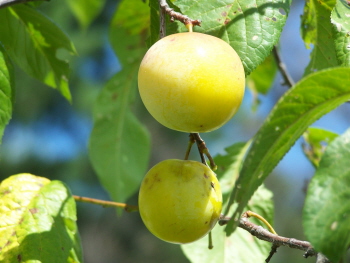Apples & Other Fruits
Species | Propagation | Maintenance
Integrated Pest Management
Species
|
Cindy and Jeff focus on apples and other tree fruits, but they grow some small fruits as well. Their fruit inventory in 2010, involving about 120 plants, included apples, cherries, pears, and plums, plus currants and juneberries. |
 |
Eight apple trees were already on the farm in 1996. Cindy and Jeff planted small numbers of fruit trees or bushes during most years from 1999 to 2009, then did a large planting in 2010. The large planting involved 45 new or transplanted apple trees in a newly established, fenced orchard; plus 17 other trees or bushes planted elsewhere around the farm.
Farmer’s Perspective: On The Bookshelf The Apple Grower: A Guide for the Organic Orchardist By Michael Phillips Jeff and Cindy rate this book, published by Chelsea Green, very highly. It explores topics such as the use and limitations of kaolin clay, techniques of understory management, and making small orchards viable through heritage and regional varieties, value-added products, and the "community orchard" model. Ecological Fruit Production in the North Bart and Jean Richard Hall-Beyer Cindy and Jeff had to write to the authors directly to get this book, but they have found it an excellent resource and well worth the effort. |
Table 5a shows the varieties of each type of tree fruit in their 2010 inventory, and Table 5b shows small fruits. Some apple varieties are unknown because the trees preceded Jeff and Cindy’s time on the farm; other varieties are unknown because they are antique or heritage varieties or because of inadequate record keeping early on (an important lesson learned!).
Cindy and Jeff have one or two trees or bushes per variety for most of their varieties, up to 5 or 6 plants per variety as of 2010. They have chosen to grow a number of apple varieties because of a personal interest in heritage apples and because mixes of varieties give more flavor to cider and other value-added products they want to offer (see Production > Harvest & Processing > Apples & Other Fruits).
Initially Jeff and Cindy obtained most of their fruit trees and bushes from a variety of nurseries and the Duluth Community Garden Program. Recently they have been developing their own trees by grafting desirable fruit varieties from scion exchanges through MOSES and the Sustainable Farming Association of Minnesota (SFA) onto a range of cold-hardy rootstocks (see below).
Table 5a. Varieties of tree fruits in 2010
Apples |
Cherries |
1628 |
Evan’s Ball |
Pears |
|
Bosc |
|
Plums |
|
Black Ice |
1Cindy and Jeff have been unable to identify some varieties and have named and described them themselves for record keeping purposes. The Clover Valley Antique, for example, produces mid- to late-season very nice, firm, red fruits that have white flesh and are great for drying, baking, and cidering.
Educator’s Perspective: Resource Tip The Midwest Organic Tree Fruit Growers Network offers informational materials for organic tree fruit production and marketing. Topic areas include general information on orchard planning, risk management, crop insurance, organic certification, soil health, grafting, pest management, and pollination. There are also specific resources for apples, pears, and stone fruits. The network, sponsored by MOSES, also produces a newsletter called Just Picked, maintains a listserve, organizes events, shares research information, and collaborates with the Organic Tree Fruit Association. The Fruit Resources page at Cornell University addresses tree fruits, grapes, and berries, with additional links to minor fruits and related topics. The Tree Fruit page covers a similar range of topics as the Midwest Organic Tree Fruit Growers Network but includes perspectives outside of the Midwest and for conventional production. There is also information on food safety, post-harvest, business management, and labor. |
Table 5b. Varieties of small fruits in 2010
Currants |
Juneberries |
Black Russian |
Regent |
Educator’s Perspective: Resource Tip Although juneberries grow wild in Minnesota and have been picked and used in homemade jams and similar products for generations, they are just starting to make a name for themselves as a fruit crop in the state and elsewhere. The species used in commercial production is Amelanchier alnifolia. Two Minnesota farmers began evaluating the commercial potential of juneberries in 2005 and summarized their findings in the MDA’s Greenbook 2008 with an article entitled Developing a Saskatoon Berry Market in the Upper Midwest. A similar effort is underway in the northeastern U.S.; see Small-scale Commercial Juneberry Establishment and Marketing from the Cornell Cooperative Extension of Ontario County, New York. Honeyberries are another up-and-coming small fruit. Also called haskap in Canada, or edible blue honeysuckle (Lonicera caerulea), they originate from Siberia, China, and Japan. The fruits are cold-hardy, ripen earlier than strawberries, and look like oblong blueberries. They have a unique taste, sometimes compared to blueberries but also with hints of raspberries, currants, and other fruits. Much of the breeding of honeyberry varieties in North America has occurred at the University of Saskatchewan Fruit Program. Some of these varieties were planted in 2011 for testing at northern Minnesota’s North Central Research and Outreach Center. |
Propagation
Jeff and Cindy use a variety of cold-hardy rootstocks (Table 6). They are testing the strengths and weaknesses of each rootstock for their site and soils by matching different rootstocks to different fruit varieties. A strongly dwarfing rootstock such as “Bud9,” for example, keeps the tree small and allows for higher density plantings and earlier fruiting at 2-3 years. These dwarf trees need to be trellised because of a weak root system that is not self supporting. Although dwarf trees may have fewer fruits per tree (about 2 bushels’ worth), the planting density and earlier yield can result in overall higher yield per acre.
Other rootstocks, such as “Antonovka,” are self-supporting, result in larger trees, and produce larger crops, but take longer to start producing; generally 5-7 years. Aside from cold-hardiness and disease resistance, Jeff and Cindy are considering which combinations work best for their objectives. Jeff and Cindy have found that high-density plantings on dwarfing stock are often preferred among growers who focus strictly on fruit production, but they feel large, self-supporting trees may be a better choice for grazing poultry through their orchard as an integrated pest management strategy (see below).
Apples |
Cherries & Plums |
Pears |
Antonovka |
Antonovic Cherry |
Fedco Pear |
Cindy and Jeff have their fruit trees and bushes distributed among various areas on the farm. Following the aerial photo of the farm (below) is a list of these areas as of 2010, as they relate to the aerial photo. Also see Appendix 2 (PDF, 158 kb) for detailed maps of fruit tree and shrub locations.

- The “Homestead Orchard” is located south of the hen coop. It contains heritage apple trees that were already growing on the farm in 1996, plus new apple, pear, and plum trees planted between 1999 and 2009. The site is adjacent to woods on the north but open on the other sides for full sun and good air circulation.
- The “Backyard Orchard,” to the north of the house, contains heritage crab apple trees and a combination of native and cultivated varieties of plum and cherry trees planted between 2001 and 2008. This is a relatively low area, in which some species have done well and others have not.
- From 2005 to 2007, Cindy and Jeff planted pear and apple trees in the “Old-New Orchard” located along Homestead Road. Many of the trees died due to inadequate drainage, and others were moved to the new Fenced Orchard in 2010. Two pears and an apple tree, individually fenced for protection against deer, remain in this area. Cindy and Jeff may use the area again in the future, by improving site preparation and drainage.
|
Farmer’s Perspective: Lessons Learned In addition to losing some information on early fruit plantings; which Cindy and Jeff have rectified with improved record keeping and the use of tree tags; they have learned important lessons about preparing sites for plantings, especially considering they have to deal with poorly drained soils on their site. So far they feel that the combination of grazing hogs through an orchard site in the year preceding a planting, plus their own tilling efforts and soil amendments, has produced good results and will help them revitalize other planting sites in the future. |
- Cindy and Jeff established the “Currant and Nursery Beds” in 2010. The beds, located southwest of the house, contain all their currant bushes, blueberry plants (for personal use), two cherry trees, and a plum tree. They plan to convert part of this area to nursery beds for their orchards; other nursery beds are currently located within their personal garden to the southeast of the greenhouse.
 |
Farmer’s Perspective: On The Bookshelf By Gail Damerow Published by Storey Publishing, this book is a guide to selecting, planning, and building fences intended to keep livestock in or wildlife predators out. It covers various types of fencing, provides illustrations, and addresses related topics such as alarm systems and zoning laws. |
|
Spotlight on: Outreach Cindy has been working to restore abandoned trees with neighbors who have heritage orchards and at a historic seedling trial orchard at the old University of Minnesota - Duluth agricultural field station, part of the newly formed Sustainable Agriculture Project. It has been a great opportunity for her to learn the skills of orchard restoration and about heritage fruits in the region. These projects dovetail with her personal interests and were instrumental in giving her the courage to try planting her own orchard using her own trees! She has begun offering a course to help others in the region to learn the skills she has found so valuable on the farm. |
Maintenance
The fruit tree operation has its own calendar, different though generally compatible with poultry and hog production. Outside of fall harvest, and once trees are established, the season starts in February with winter pruning, which keeps trees productive and in good condition. During spring and summer, Jeff and Cindy monitor blooms, fruit set and development, and pests.
Integrated Pest Management
Jeff and Cindy use integrated pest management (IPM) to manage pests in their fruit operation. As mentioned earlier, their farm’s location puts them out of range for two of the most destructive pests that plague other Minnesota growers: the plum curculio, a weevil that pierces and damages the fruit, causing it to be misshapen; and the codling moth, whose larvae burrow inside and eat their way out, leaving a hollow rotten core to the fruit. Both pests render the fruit unmarketable.
|
Educator’s Perspective: Resource Tip According to the Minnesota Department of Agriculture’s IPM Program, the goal of IPM is to mitigate pest damage while protecting human health, the environment, and economic viability. IPM is a stepwise approach involving proactive planning, setting thresholds for management actions, conducting ongoing monitoring for pests, properly identifying pests, implementing control actions, and evaluating effectiveness. Actions may include biological control (releasing or promoting beneficial organisms), cultural control (such as mowing, trapping, or destruction of pest habitat), chemical control (such as insect pheromones), and genetic control (use of resistant varieties). |
|
Farmer’s Perspective: Lessons Learned Cindy feels that participation in programs like the MDA’s IPM program is important for beginners. Even with her scientific background, she confesses that she would be likely to let weekly orchard monitoring slip if she hadn’t committed to the program. They now have two years of useful data from monitoring their own orchard, plus a neighbor’s orchard and the orchard at the University of Minnesota – Duluth. Cindy also feels that the process of writing proposals for, and carrying out, on-farm research has been very valuable to them. It has given them access to helpful contacts and forced them to think through questions and issues on the farm that they might not otherwise address. She encourages other beginners to explore similar opportunities, even without previous grant writing experience. |
Cindy and Jeff helped to demonstrate that they were out of range of these pests by participating in the MDA’s IPM Program. They do weekly monitoring of pest traps during the growing season and report to the MDA, which publishes data in the weekly Fruit IPM Update. Clover Valley Farms is one of two monitoring sites in St. Louis County. 
Minnesota Department of Agriculture IPM trap The primary pest for which Jeff and Cindy have needed to take action is the apple maggot, a mid- to late-summer fly that lays its eggs in the developing fruit. A combination of trapping and spraying with kaolin clay can keep them in check. Kaolin clay is a naturally occurring mineral that forms a white film that suppresses pests. The film can be removed by washing before eating the fruit. 
apple maggot trap |
They have been able to control apple scab, a fungal disease that can damage both fruit and leaves, using orchard management techniques. The fungus overwinters in leaves and wood, so by removing pruned and fallen branches, mowing, and allowing poultry to forage in the orchard, they can break the fungal life cycle. They also keep a close watch on their Honeygold apples, the “canary in the coal mine” for apple scab because it shows signs of the disease before other varieties.
 |
 |


